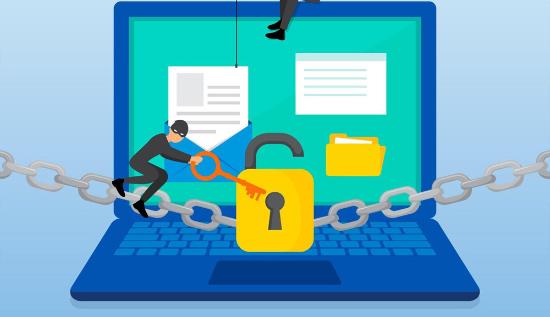How to Protect Your Business from Phishing Attacks

Discover powerful strategies to protect your business from phishing attacks. Learn expert anti-phishing measures to keep your business safe.
One of the most common threats in the digital age is phishing, which may impact companies of all sizes. These assaults propagate malware, steal personal information, and result in financial loss by taking advantage of human weaknesses.
Knowing how to protect your business from phishing is essential in the current cybersecurity environment.This thorough study examines crucial phishing prevention strategies to protect your company.
Understanding Phishing and Its Impact on Businesses
Phishing is a type of cyberattack where hackers pose as reliable businesses in an attempt to fool victims into disclosing login credentials, credit card information, or sensitive company information. These attacks frequently involve phishing emails, social media accounts, or websites. Small businesses are especially vulnerable due to limited resources, making cybersecurity for small business a top priority.
Recognizing Phishing Scams
Understanding common phishing prevention strategies is one of the first stages in phishing prevention strategies. The following are common features of phishing emails:
• Urgent language demanding quick response.
• Phishing emails that seem like real ones.
• Hyperlinks pointing to phony webpages.
Employee training against phishing must include teaching staff members to identify these indicators so they may identify and steer clear of any schemes.
Social Engineering Attacks: A Growing Concern
Phishing is a form of social engineering attack, where cybercriminals manipulate human psychology to achieve their goals. These attacks use trust, curiosity, and terror, and they often use a method known as spear phishing to target high-ranking employees.
To counter these sophisticated assaults, companies need to implement robust anti-phishing measures and promote a cyber threat awareness culture among all staff members.
The Importance of Employee Training Against Phishing
Employees are often the weakest link in cybersecurity. Giving staff members comprehensive employee training against phishing is one of the finest ways to strengthen defenses. Training should address the following topics:
• How to recognize attempts at phishing.
• The dangers associated with clicking on unfamiliar links.
• The need to report suspect emails right away.
By regularly exercising these skills through training and simulations, staff members can serve as the first line of defense against phishing attacks.
Implementing Email Security Practices
Since emails are the main way that phishing attempts are spread, having strong email security practices is essential to any cybersecurity plan.
One example of:
• A best practice is turning on spam filters to stop shady emails.
• Updating email client software on a regular basis.
• Scan incoming emails for dangers using secure email gateways.
By taking these precautions, you greatly lower the possibility that your staff may receive phishing emails.
The Role of Email Authentication Tips in Phishing Prevention
Email authentication tips are a useful way to verify the legitimacy of senders. Important tips for email authentication include:
• Using SPF (Sender Policy Framework) to verify email sources.
• Use DKIM (DomainKeys Identified Mail) to prevent content manipulation in emails.
• Enable Domain-based Message Authentication, Reporting, and Conformance, or DMARC, to stop phishing efforts from using your domain.
By adding an additional layer of security, these authentication procedures can be shield to protect your business from phishing.
Multi-Factor Authentication: An Indispensable Tool
Multi-factor authentication (MFA) is among the easiest yet most successful ways to improve cybersecurity. Users must supply two or more verify methods, such as a password and a one-time code texted to their phone, in order to do this.
Importance of multi-factor authentication is essential for reducing the likelihood of unauthorized access to private systems because it can render stolen credentials useless.
Anti-Phishing Measures for Businesses
Comprehensive anti-phishing measures go beyond employee training and email security. They include:
• Installing antivirus and anti-malware software to detect and block threats.
• Operating systems and apps should be updated often to address vulnerabilities.
• To identify and address vulnerabilities, regular security audits should be conducted.
These preventative actions result in an efficient defense against phishing and other online threats.
Malware Protection: Safeguarding Business Systems
Phishing emails often contain malicious attachments or links that install malware. One of the best ways to malware protection is to install endpoint security software on each device.
• Monitoring network traffic to identify unusual activity.
• Isolating infected systems to prevent the spread of malware.
By prioritizing malware defense, businesses may reduce the risk of data breaches and operational disruptions.
Spear Phishing: A Targeted Threat
Spear phishing is more focused than traditional phishing attempts and typically uses personal information to make the attack seem more real. Usually, the targets are executives and staff members who have access to confidential information. The effect of phishing prevention strategies depends on identifying and resolving this problem.
Protecting Your Business from Social Engineering Tactics
Social engineering tactics extend beyond phishing emails to phone calls (vishing) and text messages (smishing). Businesses should adopt policies such as:
• Verifying the identity of callers before sharing sensitive information.
• Teaching staff members about typical smishing and vishing situations.
• Promoting skepticism regarding demands that are not requested.
By taking these steps, defenses against various social engineering attacks are strengthened.
Cybersecurity for Small Businesses: Tailored Solutions
Small businesses often lack the resources of larger organizations, making them attractive targets for phishing. Tailored cybersecurity for small business includes:
• Using cloud-based security solutions for cost-effective protection.
• Outsourcing cybersecurity management to professional firms.
• Establishing clear security policies for employees.
These strategies enable smaller enterprises to build strong defenses without overstretching their budgets.
Data Breach Prevention: A Holistic Approach
Data breaches brought forth by phishing attempts usually expose confidential organization information. A thorough approach is required to Data breach prevention :
• To prevent unauthorized access, sensitive data is encrypted.
• Access limitations to critical systems depending on roles.
• Creating regular backups of data to ensure business continuity in the event of a security breach.
These protocols offer a solid basis for safeguarding your business when paired with other anti-phishing measures.
Building Cyber Threat Awareness Among Employees
Creating a culture of cyber threat awareness empowers employees to take an active role in cybersecurity. Regularly updating them about evolving phishing tactics and encouraging open communication about potential threats fosters a vigilant workforce.
Cyber threat awareness initiatives include:
• Sharing real-world examples of phishing scams.
• Highlighting the importance of reporting suspicious activity.
• Reinforcing the role of each employee in protecting the organization.
Creating a Comprehensive Phishing Prevention Plan
An effective plan to protect your business from phishing should integrate all the strategies discussed:
• Establish clear email security practices and email authentication tips.
• Prioritize employee training against phishing and regular simulations.
• Implement robust technical controls, including multi-factor authentication and malware protection.
• Regularly review and update your cybersecurity policies.
By addressing phishing at every level, businesses can minimize risk and ensure long-term security.
Conclusion
Phishing attacks remain a significant threat, but with the right combination of phishing prevention strategies and anti-phishing measures, businesses can stay protected. From fostering cyber threat awareness to implementing advanced security technologies, these steps ensure a safer digital environment for your organization.
Proactive defense is the key to success in the fight against phishing. Take action today to protect your business and its valuable data from potential threats.
(FAQs)
1. What are phishing attacks, and why are they dangerous for businesses?
Phishing attacks are attempts to steal sensitive data through deceptive emails or websites. They are dangerous because they can lead to data breaches, financial losses, and reputational damage.
2. How can small businesses implement effective anti-phishing measures?
Small businesses can use cloud-based security tools, provide employee training, and enable email authentication protocols like SPF, DKIM, and DMARC.
3. Why is employee training important for phishing prevention?
Employees are often the first line of defense. Training them to recognize phishing attempts reduces the likelihood of successful attacks.
4. What is the role of multi-factor authentication in preventing phishing?
Multi-factor authentication adds an extra layer of security, making it harder for attackers to access systems even if they obtain login credentials.
5. How can businesses detect and prevent spear phishing attacks?
Spear phishing attacks can be mitigated by educating employees, limiting personal information online, and verifying sensitive requests through secondary channels.
6. What should businesses do in the event of a phishing attack?
If a phishing attack is suspected, isolate the affected system, notify your IT team, and review logs to assess the extent of the breach.
More Articles
 16 Dec 2025
16 Dec 2025
How to Fly Drones Legally in Cambodia | Rules & Restrictions
Detailed overview of drone laws in Cambodia including registration, permits, restricted airspace and compliant drone operation in 2025.
 15 Dec 2025
15 Dec 2025
Full-Stack vs Backend vs Frontend: Which Path to Choose?
Full-Stack vs Backend vs Frontend: Compare roles, skills, responsibilities, and salaries to see which software development path fits your career goals.
 12 Dec 2025
12 Dec 2025
Top Programming Languages to Learn in 2026
Updated overview of top programming languages to learn in 2026 focused on growth potential, developer pathways, industry needs and real applications.
 11 Dec 2025
11 Dec 2025
Deep Learning Video Editing: AI-Powered Post-Production
Deep learning video editing brings advanced automation and AI precision to modern post-production, giving creators smoother, smarter ways to shape video content.